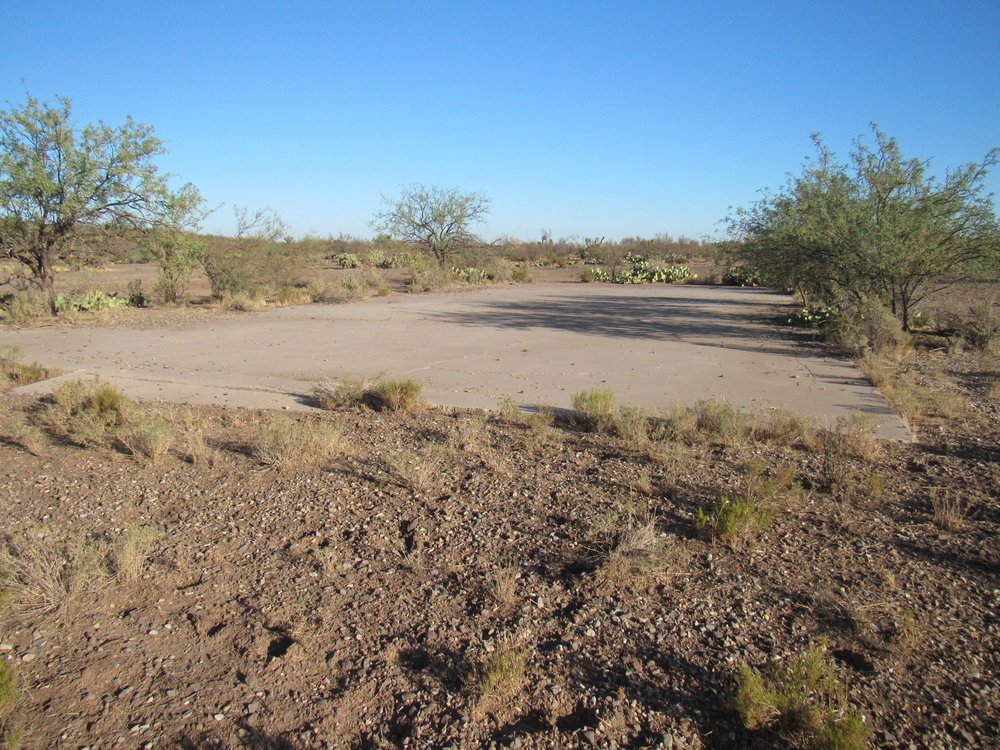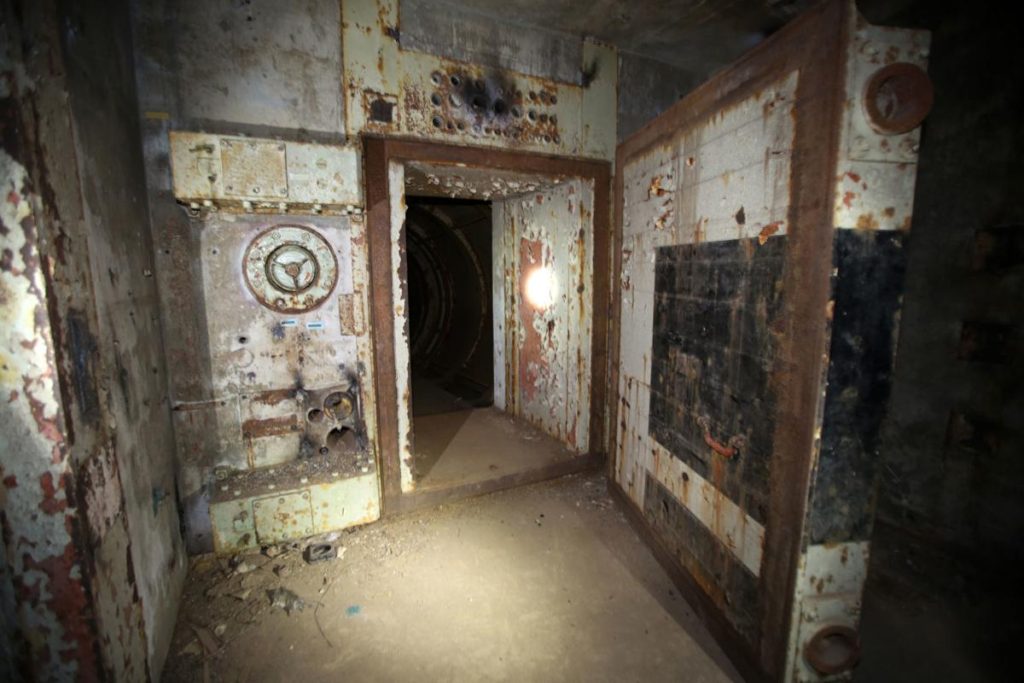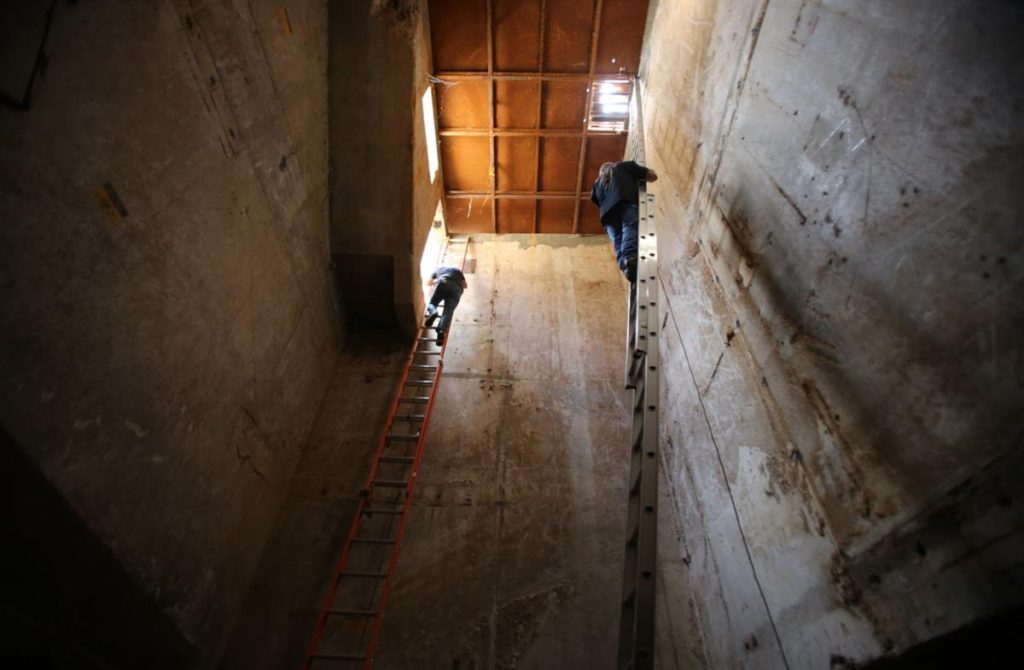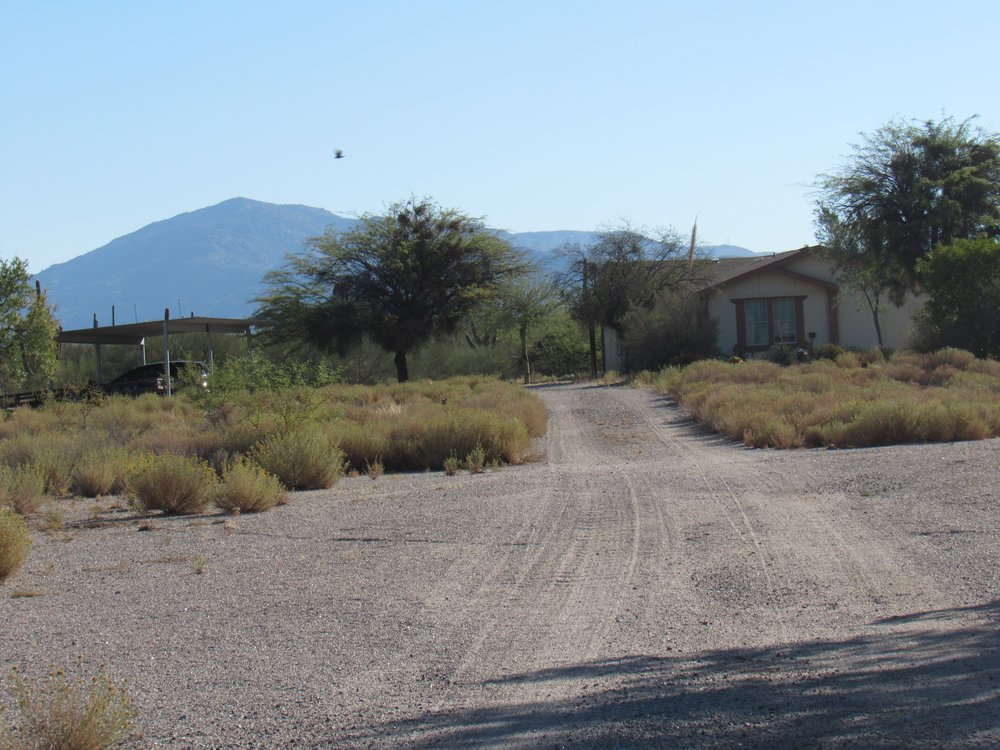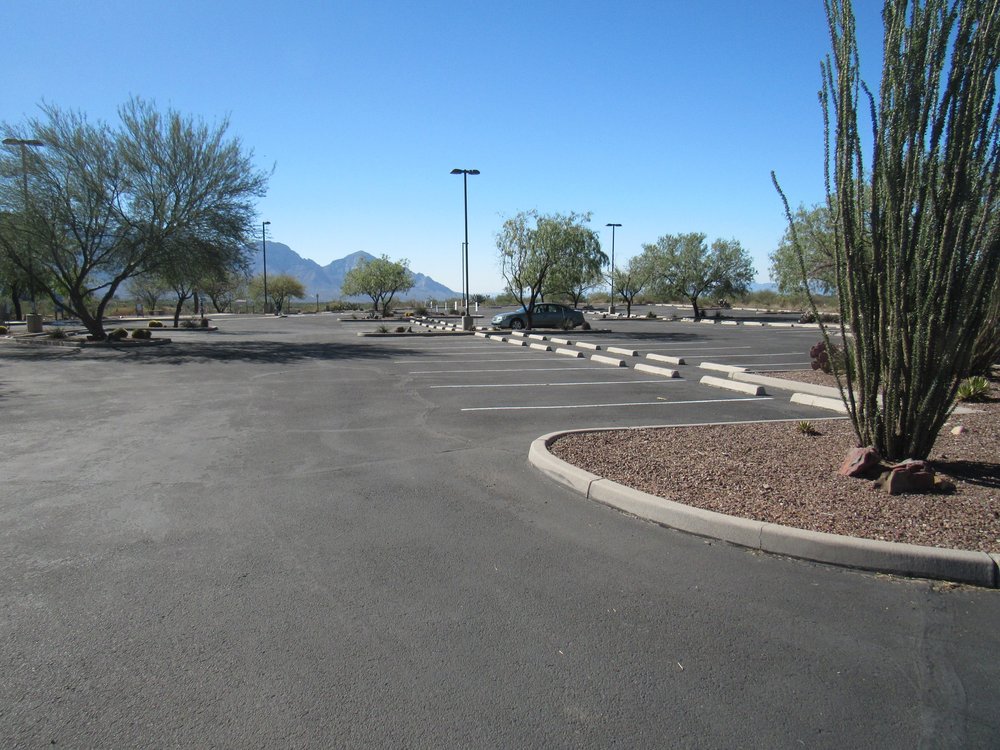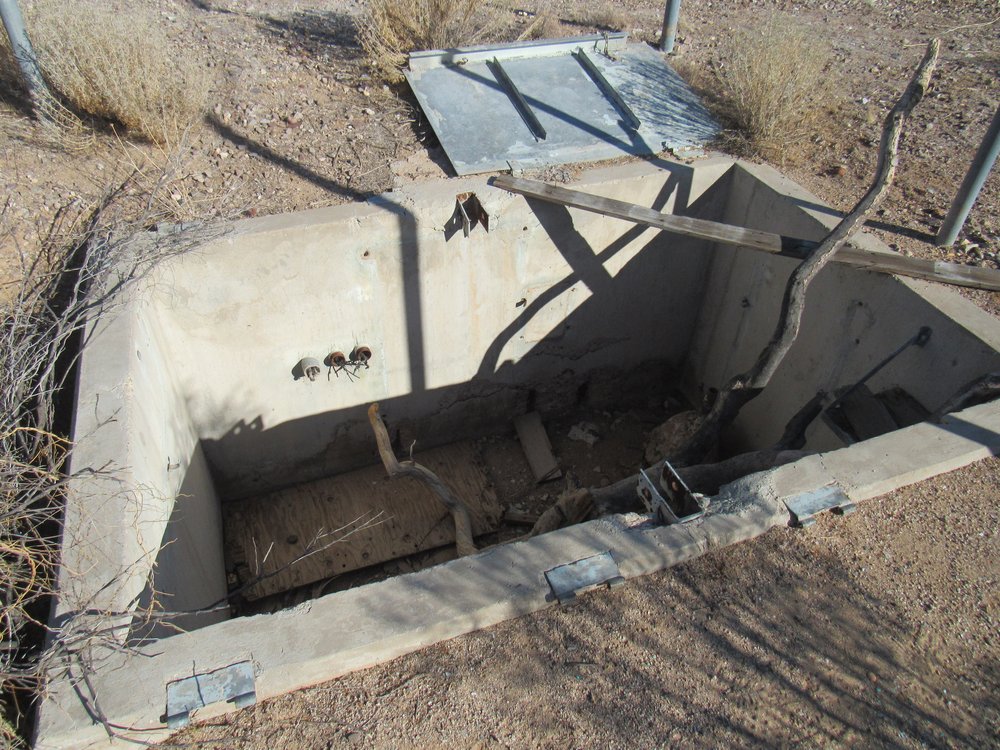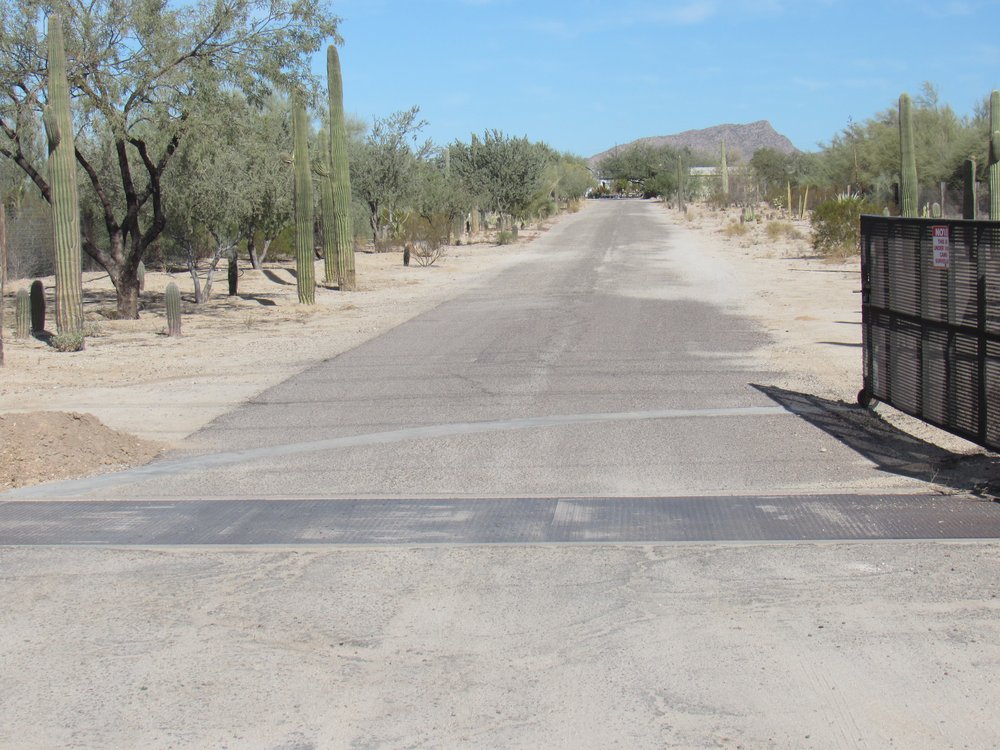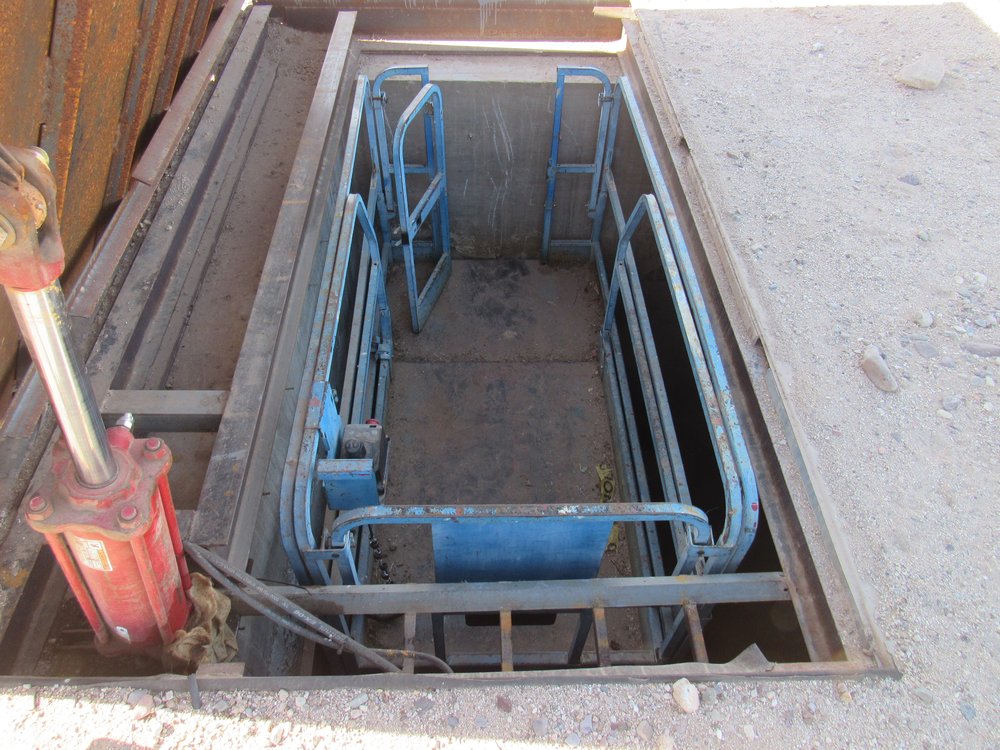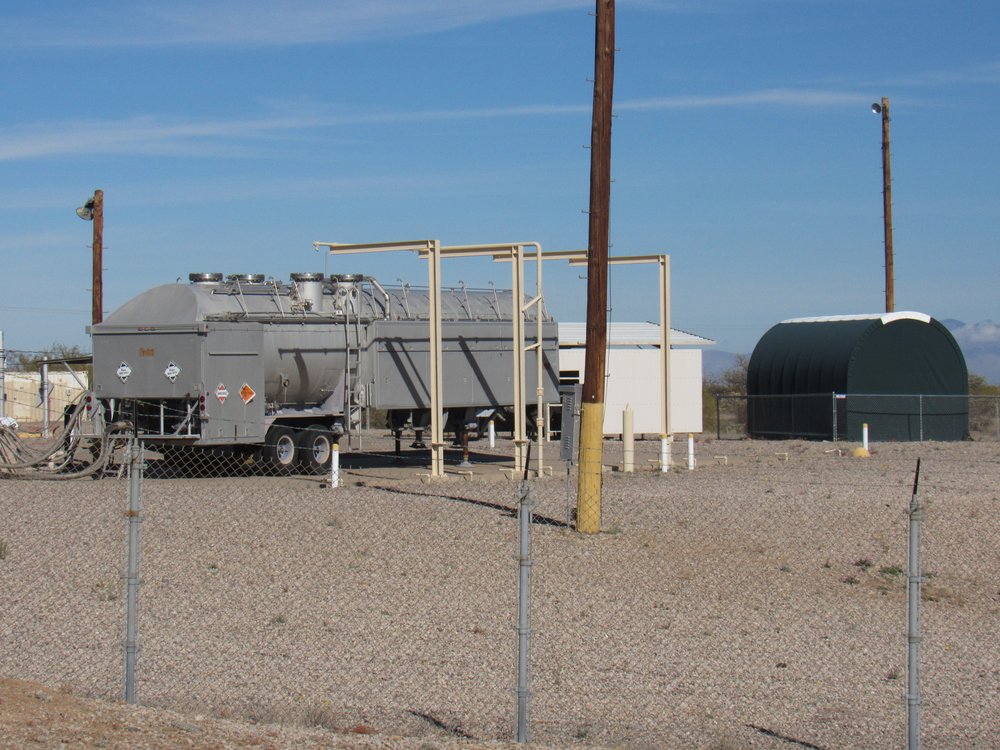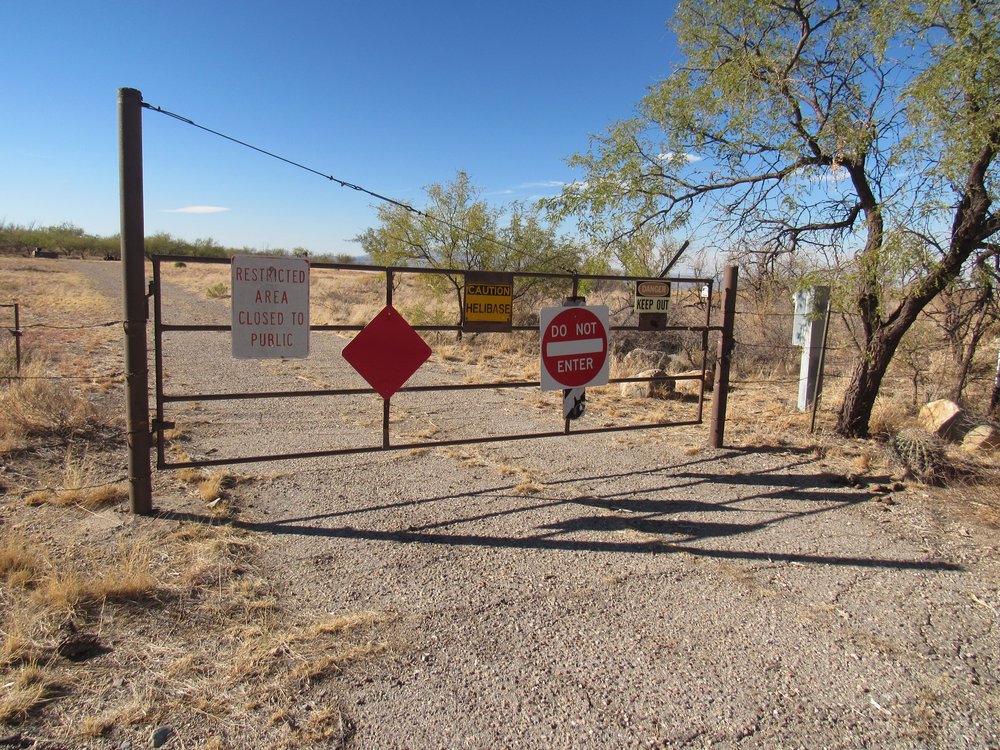Please be sure you’ve read the previous 3 installments of this story before embarking on this one.
In my quest to visit all of the Titan II missile silos surrounding Tucson, this was the very first one I saw. It was numbered 17 in the official list of the 18.
Missile Site #17 570-8 34 miles at 345 degrees from Davis-Monthan air base
This one is out in the desert, well-removed from town – you’d never know it was there unless someone told you where to look. It’s only a couple of hundred yards from a small hill known as Panther Butte (in these parts, some folks call mountain lions “panthers”). Like all the others, a tired old paved road led to the site.
When I came down from Panther Butte, the first thing I saw was the old hardstand.
Then there was this large depression lined with concrete.
Then there was this small concrete pad.
These locked containers sat in a level spot.
I had no idea what these were for – perhaps breathers for what lay under the ground.
This hatch gave access to something below, or at least it used to long ago. It’s been filled in.
There was a ladder leading down.
This looks like it led underground at one time, a hatch of some sort.
Some photos exist of what the inside of this missile base looked like after it was sold to a private buyer.
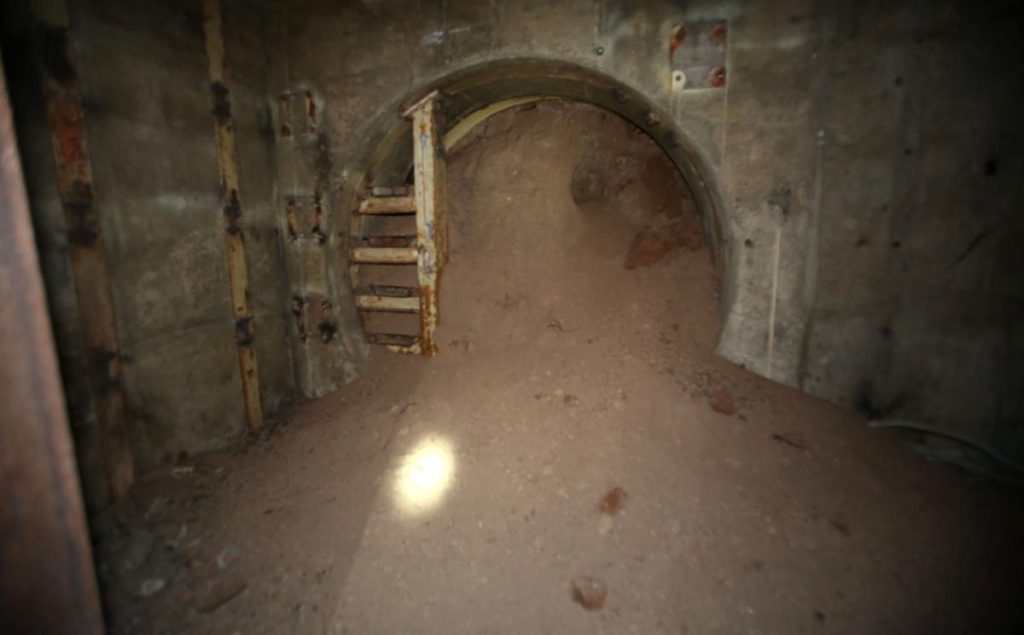
Demolition crews imploded the passageway from the the launch control center to the missile silo after the Titan Missile complex was deactivated in the 1980s.
That was everything I saw of note at silo #17. There was another nearby, which I went to next. It was officially #16 of the 18 around Tucson.
Missile Site #16 42 miles at 341 degrees from Davis-Monthan air base.
This one was 8 miles farther from town, and like #17 which we just discussed, it had its “driveway” heading east directly from US Highway 89. It was plainly marked and had a heavy gate at the entrance.
It didn’t say “No Trespassing”, so I drove through the unlocked gate and soon came to another gate which was locked. Beyond the gate, I could see that whoever owned this property had built a home and other buildings on the site.
There was nothing more to be seen here, so I turned around and left – so much for site #16. I then drove into the city, actually into a northern suburb of Tucson called Catalina. I had learned that site #18 was there, but a church now occupied that space.
Missile Site #18 21 miles at 353 degrees from Davis Monthan air base.
This one was just as I expected. Vista de la Montaña United Methodist Church now sat quietly on the acres that had once been a Titan II missile base which had stood at the ready, waiting to rain down hell on some Russian city. Much of the site was now paved parking lot.
There were several church buildings.
What wasn’t paved over was still natural desert, but I could see no trace of the missile base – it had all been removed. That’s not to say the underground parts of the base weren’t still there, but nothing was visible on the surface.
I didn’t spend but a few minutes here before moving on. The next one on my list was also north of the city, this time up in Pinal County.
Missile Site #14 570-5 32 miles at 319 degrees from Davis-Monthan air base
This one was completely accessible to the public. No gate, no fence, just drive on in. The downside was that there wasn’t much to see.
This looked like it had been an entrance to something at one time.
These seemed to be at every missile base I visited.
Although you could enter the old site, they sure didn’t want you dumping trash there.
From here, I headed back into town along the freeway, and when I reached Tangerine Road I headed east a bit until I came to a turnoff to Acacia Nursery. This was one of the closest missile bases to Tucson of the 18 that surrounded the city.
Missile Site #15 570-6 23 miles at 319 degrees from Davis-Monthan air base
As usual, a nice paved driveway led into the site.
Once inside, I had the good fortune to meet the owner, a man named Doug. He was intimately familiar with all things to do with our missile bases and shared many facts with me. He gave me a bit of a tour around the place, and I saw things here that I hadn’t in any of the others. For example, here was an opening that led deep underground and had a motorized lift to descend into the silo.
He showed me this, a hole that had been filled with concrete – I think this had been the emergency escape hatch. He had painstakingly jack-hammered it all out so that he could now descend 60 vertical feet into the underground base on the metal ladder still in place.
The owner really has a nice site, with expansive views out over the desert in all directions. He says he plans to build his home here, and I have no doubt it’ll be amazing.
One of the missile sites is unique. When the bases were decommissioned, arrangements were made that one of them could be preserved intact and serve as a site for the public to visit. It’s in private hands, and is known as the Titan Missile Museum.
Missile Site #8 571-7 20 miles at 199 degrees from Davis-Monthan Air Base
They have done an amazing job of preserving this site. I strongly recommend that, if ever you are in the vicinity of Tucson, Arizona, you drive about 20 miles south of town along Interstate 19 and pay a visit to this place. Here is a link to the museum. Here’s another one. Touring all of the underground facilities is a real eye-opener, a chance to see something that few will ever see or understand. I stopped by the place recently to take a few pictures, and even the above-ground stuff is impressive. Here’s some of what I saw.
The above photo shows one of the trucks they used to fuel the missile. From time to time, they removed the old fuel and replaced it with new.
Every site had one of these huge antennas – it must have been 50 feet tall.
This sign was near the antenna.
This is the building that houses the museum and the entrance to the silo.
I cannot recommend this museum too highly – it’s a world-class place that you should see, it’ll blow your mind.
Next on my grand tour was this one, south of Tucson and hard by the impressive Santa Rita Mountains.
Missile Site #6 571-5 29 miles at 180 degrees from Davis-Monthan Air Base
This one sits alongside a paved road that leads to the popular tourist spot known as Madera Canyon. At an elevation of 4,100 feet, it is by far the highest of all the 18 sites around Tucson. This is a curious spot. As you turn in to the site, this sign greets you.
There’s a big locked gate.
Once past the gate, you come to a large cleared area that is no doubt covering all of the underground base. There are the usual concrete slabs.
A trailer bearing a U.S. Government license plate sat beside a shipping container.
Possibly someone lived on the site, but if so they had no running water or electricity. There was another curious spot on the grounds.
An outdoor table with seating and a roof to shelter it sat over in one corner of the property. All of this sat on a metal platform, which sure did look like it covered the entrance to something underground. I got the impression that this site had never been in private hands. Rather, it sat on U.S. Forest Service land, and if it were being used as a helicopter base by some government entity, that would serve to protect it from curious public like me. There wasn’t much else to see, so I soon left.
Now we come to the last of the 18 missile sites that I visited. In many ways, this was the most interesting one of all.
Missile Site #7 571-6 38 miles at 196 degrees from Davis-Monthan Air Base
This one is located to the south of Tucson, just off of Interstate 19 and on the way to the Mexican border. It is approached by a mile-long paved road from the freeway.
There was a gate along this road which was plainly marked with “No Trespassing” signs. The day I arrived, the gate was wide open so I thought I’d take a chance and drive on through, hoping I might meet someone. I parked beside a house and a man came out shortly afterwards. He asked me why I had ignored the signs, and I told him I was writing a story on the 18 Titan II missile bases that surrounded Tucson. I apologized, and asked him if I could talk to him for a bit. He seemed okay with my presence and we ended up spending more than an hour conversing on his front porch.
The previous owner had built a small motel on the site, and when this man had bought the property he then converted the motel into a spacious home where he now lived. He told me that there wasn’t much visible when he first moved there. After having obtained some actual blueprints of the missile base, he determined what was where and set out to uncover some of what the military had buried. With his back-hoe, he spent 5 hours a day, 5 days a week for a full 5 months and removed tens of thousands of yards of dirt to expose parts of the underground base. He then back-filled most of it but left himself access to important parts. Have a look at this. Inside a workshop he was building was this scissor lift next to a metal stairway which descended 35 feet into a shaft.
Once his excavation had exposed this shaft, he made some large concrete slabs to block it up again and then back-filled it.
I could look all the way down to the bottom of the shaft.
The owner said that down at the bottom of the shaft was access to the underground tunnels that led to the rest of the missile base. I didn’t go down to the bottom, but I have a feeling he would have let me if I’d asked. How exciting!!
He also solved a mystery for me. Do you remember the pictures I took at all the other missile sites I’d visited? Something I kept seeing at nearly every one of them were concrete pads that looked like this one. He told me that these were antenna pads. That semi-circular door would open up and an antenna would raise up for communication. There were two of them on each site – in case one were disabled, there was a back-up.
Here’s a picture of a control panel he had brought up from below – he said there was plenty of stuff like this sitting untouched down in the underground base.
To me, the most striking thing about his property were the stunning 360-degree views he had, unbroken in every direction. To the west sat Diablo Mountain rising 1,600 feet above his property.
To the east he had this view of Mount Wrightson.
I thanked him for generously giving of his time to me and finally left, realizing that I had learned more from him than I had at any of the other missile bases.
And that, Folks, wraps up our tour of Tucson’s Titan II ballistic missile sites. I had a great time visiting them all, and I hope you found some interest in what I shared with you. My goal was never to be somber or negative in writing this series, although the title “Armageddon” may at first give that impression. In actuality, I simply wanted to shed light on the fact that Tucson, my home town, played an important part in the entire Cold War era through which I personally lived.


